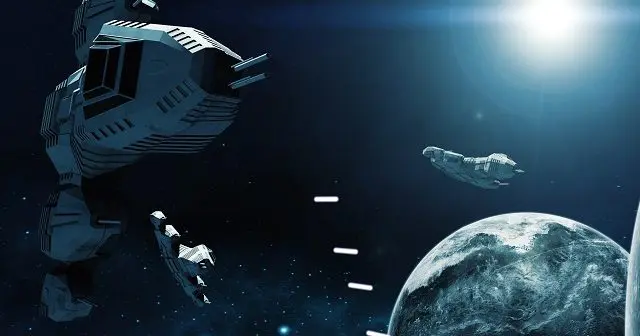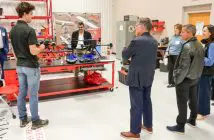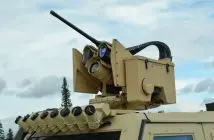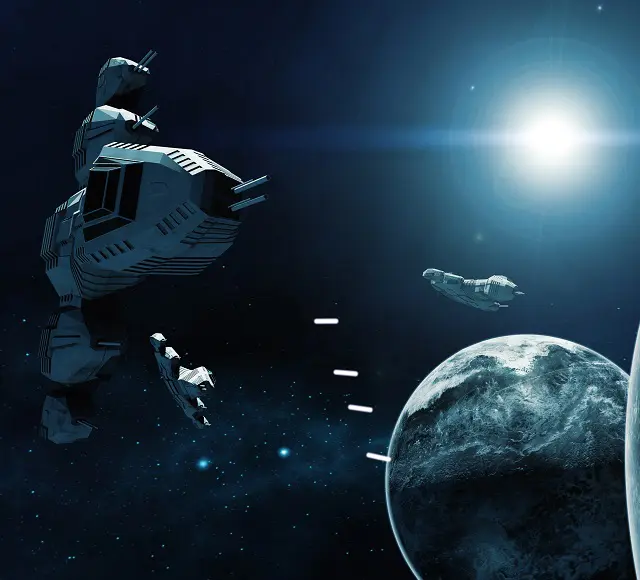
INTRODUCTION
The current focus of Space-to-Space War, or Space-Based Battle in Earth Orbit is combat between ground controlled Satellites. Potentially in the near-future Spaceships and Space Stations could be included. In the past, some limited conceptual and potential weapon development has occurred in regard to possible individual combat between Human rather than Robotic Astronaut-Soldiers. This exploratory paper looks at the potential shape of such combat based on current technology. Topics discussed include tactical formations, based on the concept of Inverted Combat, Human limitations, and the personal weapons likely to be used, in a notional Zero-Gravity Three-Dimensional Spherical Space Combat Zone. The paper ends with a discussion of the notion of Space-to-Space War, or Space-Base Battle.
INVERTED COMBAT
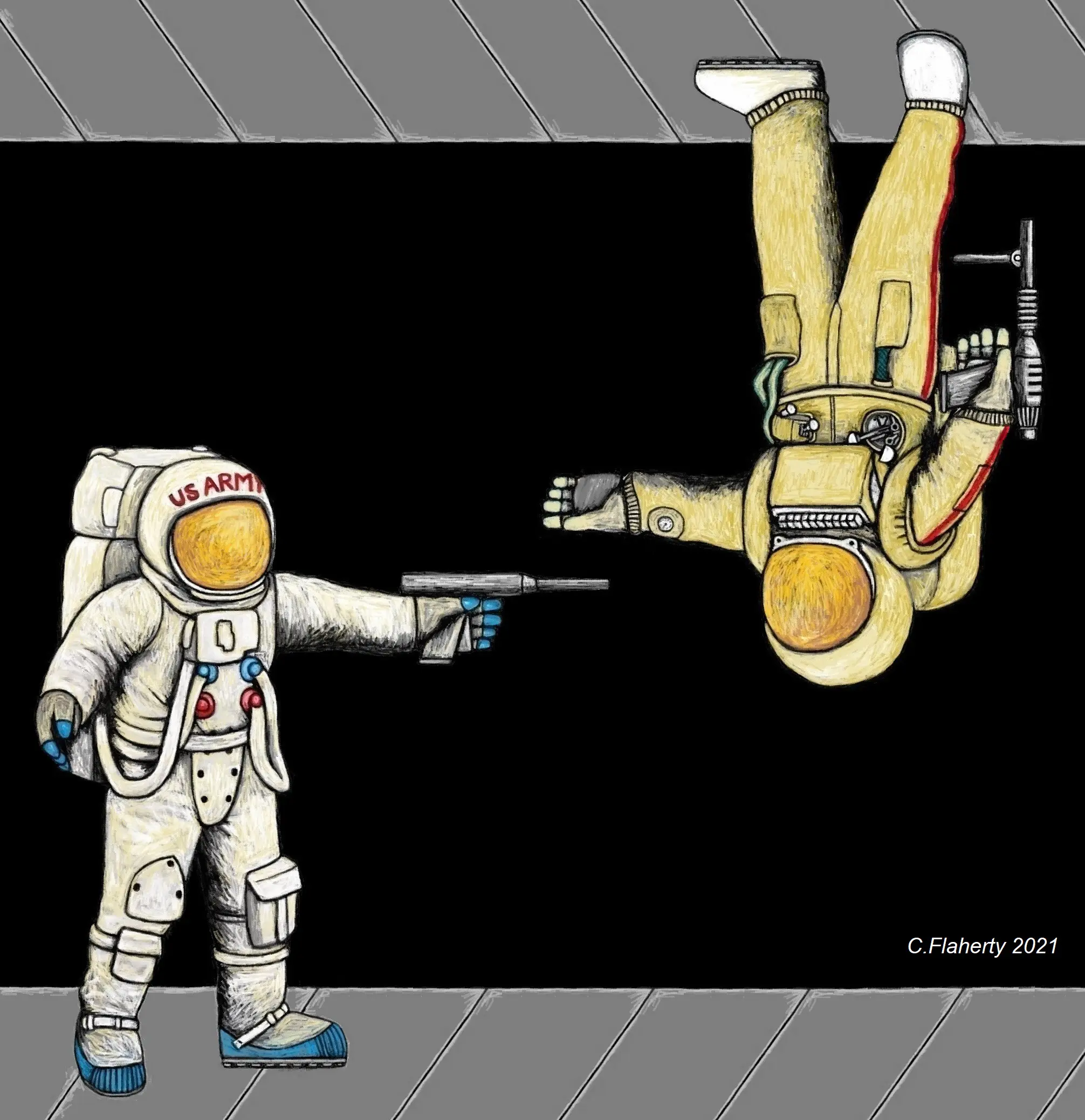
“FIGURE 1: Illustrates two Human Astronaut-Soldiers in Inverted Combat.”
Individual combat between Humans in a zero-gravity environment is one of the oldest science-fiction tropes, and fictional props. A lesser-known science-fiction movie or television scene is where a Space Station has interior cabins and hallways with opposing facing floor-surfaces. Face-to-face, two people stand on each floor-surface, and are upside-down in relation to each other. Now picture, a scene somewhat reminiscent of ‘Relativity (World Without Gravity)’ (Escher, 1953), where two Human Astronaut-Soldiers attack down a Space Station corridor towards each other, each moves along one of the opposing floor-surfaces, inverted in relation to the other. This is a notional Inverted Combat scenario in a zero-gravity environment (see FIGURE 1).
This exploratory paper seeks to expand the Inverted Combat scenario looking at how Astronauts currently manoeuvre during Extravehicular Activity outside a Spacecraft beyond the Earth’s appreciable atmosphere, inside the International Space Station (ISS), or inside a Space Capsule. From these examples we can get a clear appreciation of the limitations experienced by a Human in a zero-gravity environment. The real-world notion of individual combat and tactics during a Space-to-Space War, or Space-Based Battle in Earth Orbit will be explored in relation to three possible scenarios:
| INDIVIDUAL COMBAT BETWEEN HUMAN ASTRONAUT-SOLDIERS | → | FREE-FLOATING IN SPACE |
| ON SURFACE OF A SPACESHIP OR SPACE STATION | ||
| WITHIN A SPACESHIP OR SPACE STATION |
The main focus of this exploratory paper will be a Space-Based combat scenario between two groups of Human Astronaut-Soldiers: called Blue and Red Forces free-floating in a zero-gravity environment. This will likely see new tactics evolve that reflect Human limitations, in relation to a notional Zero-Gravity Three-Dimensional Spherical Space Combat Zone. The size of which is determined by the distance at which weapons they use are effective (which is discussed later in this paper). This represents a radical shift in tactics from that which have evolved on the Terrestrial Surface of Earth, namely a notional Tactical Half-Sphere, grounded on a two-dimensional surface.
This exploratory paper will focus on likely combat in terms of current technologies. It is assumed that a free-floating Human Astronaut-Soldier has the ability to propel, and manoeuvre themselves using an Astronaut Maneuvering Unit (as have been historically developed for the Space Program). However, in two of the scenarios: Spaceship surface, and Space Station interior we could imagine the use of some type of surface-gripping sole on their footwear, allowing a Human to stand and walk upright on an interior deck surface, or on the outer skin surface of a Spaceship in a zero-gravity environment.
Combat on the exterior surface of a Spaceship or Space Station, or within the interior of these (an internal wall, or floor-surface), is the closest a Human can experience upright positioning in relation to an object in Space. However, unlike Terrestrial-Based combat, the possibility exists for an Inverted Combat scenario occurring; and in terms of current Human experience in a Space Station, or on a Spacecraft, this can be problematic:
“[As] … the lack of architectural contrast between these surfaces produces a psychological effect: Up and down can be switched in the minds of crew members floating weightlessly through the modules. Known as the visual reorientation illusion, this phenomenon can cause disorientation, confusion, and nausea. Crews combat this by using lines of lighting, end-hatch shapes, information signs, and labelling as visual cues to create the sense of a floor reference plane.” (Nixon, 2018)
Inverted Combat raises the possibility of a radical shift in tactics, than the ‘normal’ conditions experienced on the Terrestrial Surface of Earth. It is conceivable that on a Spaceship, or Space Station two people can stand face-to-face, each on opposing floor-surfaces. In effect upside-down in relation to each other during a fight between the two. Issues like disorientation, and loss of control in a weightless environment will be discussed in the next section on Human limitations in a Zero-Gravity Three-Dimensional Spherical Space Combat Zone.
Through-out this exploratory paper, the term Human Astronaut-Soldier will be used, even though the, “term Astronaut applies to all Humans in Space” (Ramey, 2000). The phrase: Human Astronaut-Soldier, has been purposefully used to differentiate from Robotic Combatants, which are seen as the most likely military course of development in the conduct of a near-future Space-to-Space War, or Space-Base Battle. The notion of a Robotic Astronaut-Soldier will be addressed at the end of this paper.
HUMAN MOVEMENT AND LIMITATIONS
As mentioned earlier, disorientation is a limitation factor that can be experienced by a Human in Space, where there is no ‘up or down’. Seeing Astronauts at work tethered to a Space Capsule, or outside the International Space Station (ISS) their movement appears slow and ponderous. The slow movement results from the need to be careful. The mass of a Human body, its muscle power – all potentially directly translates into momentum. A weightless environment, means a Human cannot rely on the force of gravity, or friction and resistance to slow or stop movement. When an Astronaut launch themselves the momentum is such that they can only stop if they grab a fixed object, hold onto something, or press against something close to the perpendicular of their movement-direction. An Astronaut can easily build-up speed by jumping with all their force, or springing from a wall of a Spaceship or Space Station. Their momentum can be such, resulting in being catapulted with force into another object causing injury, even death, damage their Spacesuit, or damage the object they are hitting like a projectile.
TERRESTRIAL SURFACE TACTICS HALF-SPHERE
More specific Human limitations arise in relation to individual combat in Space. To start with, individual martial arts training, and weapons handling proficiency, sits at the base of all warfare, and much of the tactical concepts are a result of the Human Form. As bipedal apex-predators. Humans have forward positioned eyes giving 180 degree vision, which is extended by peripheral vision, head, and body rotation on a vertical axis. The basis of the Human fighting stance is positioning on a two-dimensional surface, which extends to a three-dimensional space, where all movement, weapon’s range, and effects is determined by the Earth’s gravity. Essentially, on the Terrestrial Surface of Earth conventional combat tactics have been shaped by a half-sphere of space: the ‘Tactics Half-Sphere’ (see FIGURE 2).
The historical shift toward forward facing mass-tactical formations, was largely an intentional sacrifice of individual tactical flexibility offered by an individual Human Soldier operating with a higher-degree of weapons competency, and individual martial skills, than that seen among mass-formation Human Soldiers. Tactics are largely reduced to the direction of engagement, and line-of-sight use of weapons in order to maximise mass weapons effect, and to create a linear barrier as a means to achieve battlefield control. Essentially performing a blocking manoeuvre, a unit of Human Soldiers, are given distinct fronts, rear of the formation, and flanks, which have been the traditional formation weaknesses, that require protection by other formations, and weapons.
Dismantling the linear, and the depth formation of Human Soldiers on a battlefield in favour of disaggregated groups of tactical-operating individuals re-introduces the Tactics Half-Sphere. Each individual tactically operate within their own area, and contributes to the security of other Human Soldiers within their vicinity. The battlefield radically shifts from having a front and rear to a series of expanding, and intersecting Tactics Half-Spheres, some of which over-arch many smaller ones, representing longer weapons ranges, and weapons effects.
The radical shift into a zero-gravity environment of Space, where the Human Soldier becomes the Astronaut-Soldier, and the Tactics Half-Sphere, which is largely grounded on the Terrestrial Surface of Earth, becomes notionally a spherical three-dimensional space. Within that space a Human is fundamentally limited. Comparatively, the Human Astronaut-Soldier has to operate more like an Omnidirectional Being (which will be discussed next).
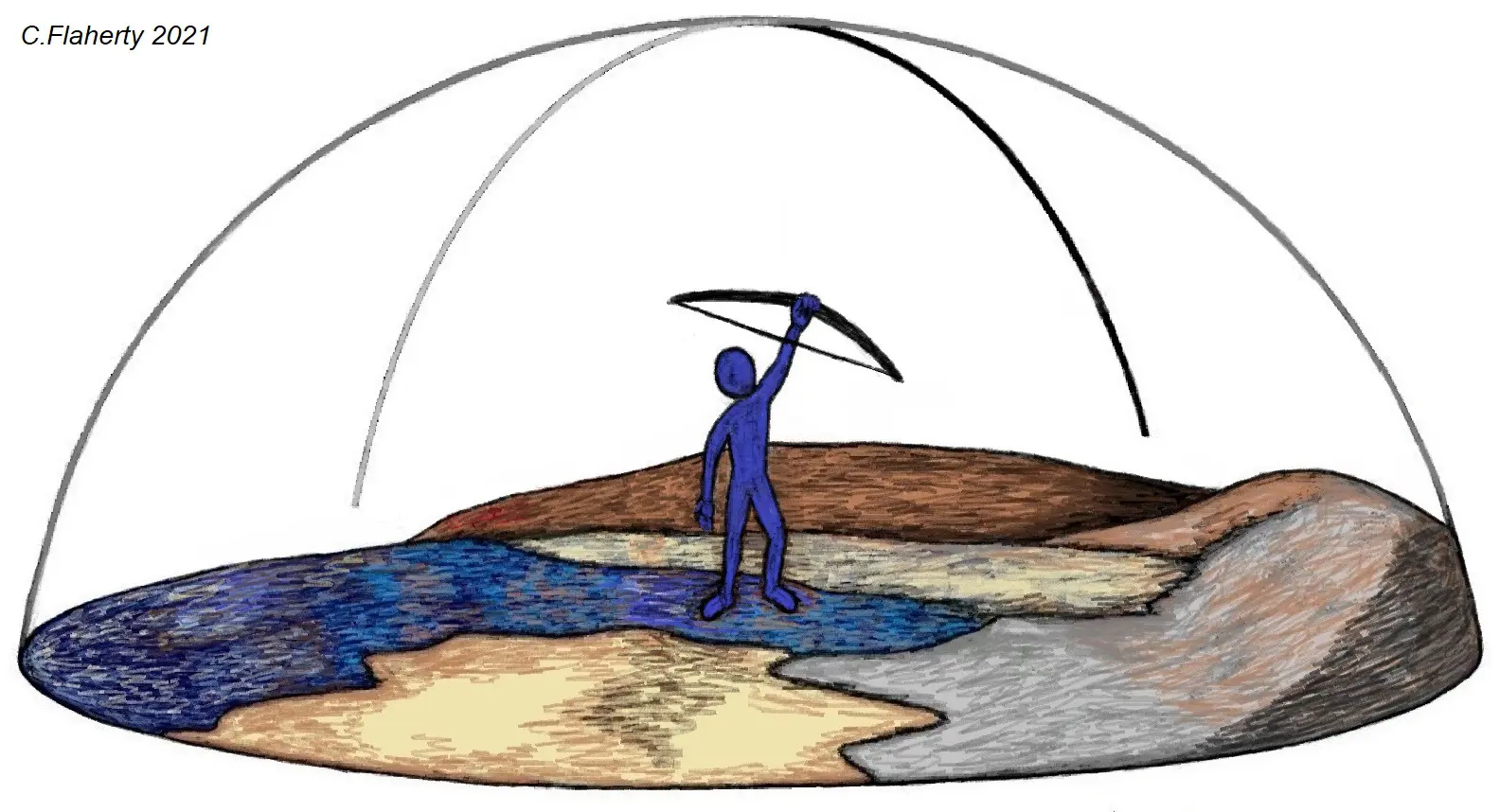
“FIGURE 2: An ancient bowman fires an arrow. On the Terrestrial Surface of Earth, conventional combat has largely evolved taking place within a Tactics Half-Sphere.”
FIGURE 2: Represents an ancient bowman. Their body movement range, and the range and effects of their weapon, determine a notional Tactics Half-Sphere. Within this space combat tactics have evolved. Proportionally-sized according to the individual it surrounds, which relates to the range and effect of the weapon they are using, or the reach of their own body movement in a combat. Historically, in conventional warfare the notional Tactics Half-Sphere dissolves where any type of formation warfare has been used.
THE OMNIDIRECTIONAL BEING
A Human Astronaut-Soldier placed into a floorless three-dimensional space in a zero-gravity environment has to operate on a completely different set of principles. The see-and-aim directionality of Human combat which essentially evolved within a Terrestrial grounded Tactical Half-Sphere of action, has to radically shift to a Human operating as a type of Omnidirectional Being. A literary description of an all-seeing circular being, is known from early religion:
“As for their appearance, the four of them looked alike; each was like a wheel intersecting a wheel … Their entire bodies, including their backs, their hands and their wings, were completely full of eyes, as were their four wheels.” (Ezekiel)
The literary description of the spinning wheel-like being covered with eyes, provides the basis for a notional construct: The Omnidirectional Being. This is a notional construct that allows us to visualise a type of tactical entity – which is likely to be a Robotic Combatant. It tactically operates at the centre of three-dimensional spherical space. Multi-direction of weapon’s ranges and effect, like individual combat and manoeuvre possibilities – are all omnidirectional (Flaherty, 2020c). The Omnidirectional Being has a panoptic view – seeing in any and all directions. It operates fixed on a point in Space. The second intrinsic element, from a combat view, is that manoeuvre would be omnidirectional, allowing for multiple directional engagement. The Human Form as it has evolved on the Surface of Earth, in comparison to the Omnidirectional Being has a major set of limitations.
The Human Form has an upright positioning with a head and feet. The eyes cannot operate in a panoptical fashion. Humans have an immediate limitation, in a spherical space, as only a quarter is likely surveilled at any point in time. To cover any of the other spherical quarters, require reorientation, and complete inversion. In the next section individual manoeuvre in zero-gravity environment in relation to tactical development will be explored.
HUMAN ASTRONAUT-SOLDIER INDIVIDUAL COMBAT
The central problem for a Human Astronaut-Soldier’s individual combat in a Zero-Gravity Three-Dimensional Spherical Space Combat Zone is that the potential for manoeuvre and combat is essentially omnidirectional. Physical Space is an intersection of three linear dimensions, and the sphere emerges as a Tactical Shape, in light of the key attribute of Physical Space (Flaherty, 2020c). The intrinsic element, from a combat view, is that manoeuvre would be omnidirectional, allowing for multiple directional engagement. At a fundamental level Space is a vacuum, and a boundless three-dimensional expanse where objects and events have relative positions and directions (Flaherty, 2020). That being the case, the sphere can be seen as a Tactical Shape: like the line, square, block, or triangle are all Tactical Shapes that have inherent tactical uses that evolved during the history of Human Terrestrial-Based conflict.
As we have discussed earlier in this exploratory paper, the Human Form evolved on the Terrestrial Surface of Earth. In comparison to the Omnidirectional Being, the Human Form has key limitations, that have to be compensated by a new type of tactical formation, that allows a group of Human Astronaut-Soldiers to operate as a type of merged entity. The most likely tactical formation to help overcome Human limitations, are two notional constructs, called: the ‘Hanging Bunch Formation’; and ‘Orbit Manoeuvre’. This will be examined next, in terms of a combat between two Space-Based Red and Blue Forces (see FIGURE 3).
Hanging Bunch Formation
The notional Omnidirectional Being, was discussed as a means of comparison with Human combat limitations in a Zero-Gravity Three-Dimensional Spherical Space Combat Zone. The solution was the adoption of a type of herding tactic: the Hanging Bunch Formation. As stated, the major limitation of a Human Form in spherical space is only a quarter is likely surveilled at any point in time, by an individual. To compensate for an attack-manoeuvre that can come from any direction, a type of collaborative grouping of Human Astronaut-Soldiers needs to be organised, and to cover any of the other spherical quarters, requires reorientation, and complete inversion.
FIGURE 3:1. Illustrates a Human Astronaut-Soldier Blue Force, who have set-up a basic defensive formation: Hanging Bunch Formation in a Zero-Gravity Three-Dimensional Spherical Space Combat Zone. Positioned along a notional central axis the formation is intended to operate as a herd-like tactic. Formed with a minimum of four Human Astronaut-Soldiers in a basic tactical team-unit. This potentially gives each of the team-unit members a 180 degree surveillance of a portion of spherical space: effectively dividing the sphere into four quarters. Largely an extension of a basic tactical mirroring back-to-back formation, with an inverted mirror portion. Where there are less-than-four, or one, or two then the only option might be to position near an object, and defend outwards. Such a tactical manoeuvre would likely use a Satellite, Spaceship or Space Station as back-cover. This would then operate like a conventional Terrestrial Surface Tactical Half-Sphere.
Orbit Manoeuvre
It can be anticipated that a type of Orbit Manoeuvre might evolve to attack the Hanging Bunch Formation.
FIGURE 3:2 (B to D). The Human Astronaut-Soldier Blue Force occupy the central axis of the spherical combat space. Adoption of a type of herding tactic: the Hanging Bunch Formation, as noted earlier is essentially a static defensive position. This is likely setup as a primary defence against Orbital Manoeuvre.
FIGURE 3:2 (A to C). The Human Astronaut-Soldier Red Force attackers rotate around seeking opportunities to attack and break-up the defensive formation. Positioned on a notional outer ring of the spherical combat space these perform an orbit around the central axis occupied by the Blue Force seeking vulnerabilities and openings to attack.
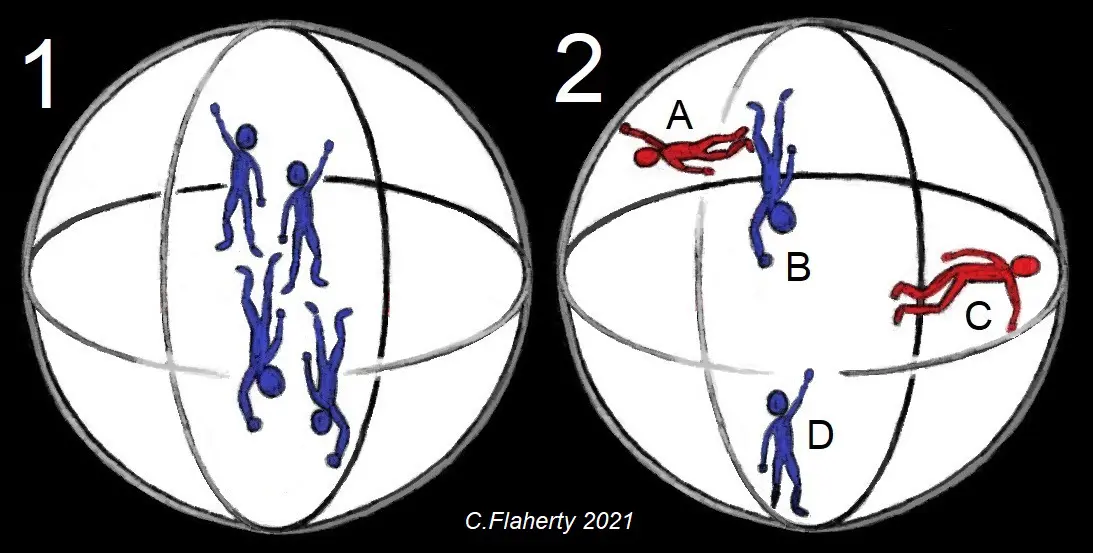
“FIGURE 3: Illustrates two Space-Based opposing forces of Human Astronaut-Soldiers in two different scenarios: (1) A defensive Hanging Bunch Formation; and (2) an attacking Orbit Manoeuvre, taking place in a Zero-Gravity Three-Dimensional Spherical Space Combat Zone.”
LIKELY END-POINT OF FUTURE TACTICAL DEVELOPMENT
A likely end-point of future tactical development, is achieving full omnidirectional manoeuvre, fighting and tactics. This would require a Human Astronaut-Soldier being capable of spinning, at its current location and acquiring any direction to attack, or able to attack in any, or multiple-directions simultaneously in Space. An omnidirectional operating Human Astronaut-Soldier notionally lends itself to the application of a spherical (three dimension) version of the OODA loop cycle: Observe-Orient-Decide-Act (Boyd, 1996).
The Human Astronaut-Soldier’s decision experience, occurring within a three dimensional version of the OODA loop cycle, is intended to largely mirror the experience of operating within a three-dimensional spherical space. As a framework for tactics evolution, this has multiple vectors, and decision points occurring in staggered succession, or several simultaneously. The end-point of future tactical development is to directly mirror a Human Astronaut-Soldier’s decision experience of three-dimensional spherical space, and translate this into omnidirectional action: manoeuvre, fighting and tactics. In short, the end-point is a Human Astronaut-Soldier who thinks spherically, and is trained for spherical tactics (Flaherty, 2020).
SPACE-BASED INDIVIDUAL COMBAT
Several factors shape the concept of Space-Based individual combat. The first factor, is that the closest approximate to Space-Based individual combat experience is an underwater fight between divers which also occurs in a largely weightless environment. The main difference, between combat occurring in a fluid medium – underwater – on the Earth’s Terrestrial Surface, and that experienced in zero-gravity,
“[is]… many crucial features of true freefall are missing, most notably the lack of resistance to movement and the importance of bodily inertia.” (Bruere, 2016)
The second factor shaping the concept of Space-Based individual combat, is that in a Space environment from a Human perspective there is no ‘up’ or ‘down’. A Human in order to cover the whole field of potential attack vectors which is notionally a spherical space, has to operate within a collective formation: the Hanging Bunch Formation (discussed earlier). Further, in zero-gravity (as was discussed earlier) the mass of the Human body, and its movement generates its own momentum that can have unpredictable results. It is also the case, that a Human largely has to rely on the body’s own inertia to stop spinning. For instance, if two Human Astronaut-Soldiers in combat were to hit each other, the likely result both would fly apart in an opposite direction. Whereas, a rapid movement with a leg extension: a kicking action, will cause the Human Astronaut-Soldier to rotate backwards into a circle-spin.
The third factor shaping the concept of Space-Based individual combat, is the ability to use momentum as a weapon. Often referred to as a buckler: a small round shield held by a handle or worn on the forearm, the traditional combat manoeuvre, was to butt, similar to the use of a baseball bat, push, or gentle tap without swinging. This type of traditional manoeuvre used in Space, might give rise to a more aggressive tactic, likely associated with the Orbiting Manoeuvre; namely adopting the head-butting attack used underwater by fishes. A Human Astronaut-Soldier travelling towards an opponent, or a larger Hanging Bunch Formation, could easily build-up speed by jumping with all their force, or springing from a wall of a Satellite, Spaceship or Space Station. Effectively catapulted with force into their opponent, hitting like a projectile causing injury, even death, or damage the opponent’s Spacesuit, or simply cause the Hanging Bunch Formation to fly apart.
The fourth factor shaping the concept of Space-Based individual combat was identified by a 1965 U.S. Army study. The study argued transition of a Human combat scenario to the Lunar Surface would require a complete redefinition of the enduring features of tactics:
“It should be kept in mind … that Penetration and Lethality on the Moon are almost synonymous since Penetration of a pressurized vessel on the Moon may be tantamount to defeating it.” (U.S. Army, 1965)
Penetration and Lethality Equivalence as a new tactical concept, not only applies to pressurized structures that could house Humans on the Lunar Surface, but equally applies to a Spacesuit, Spaceship, or Space Station. The Penetration and Lethality Equivalence translates into two Human Astronaut-Soldiers in combat manoeuvring into direct contact, in order to grapple and hold each other. The object being, like two divers attempting to compromise the opponent’s breathing gear, or mask.
Penetration and Lethality Equivalence applied to a combatant wearing a pressurized Spacesuit, was recognized as a major modification to Space-Based individual combat: “it might be sufficient to penetrate a … [Spacesuit since it] … would then suddenly decompress.” (U.S. Army, 1965) A weapon was envisaged, namely a short-range (estimated to be some three to six feet: 1.8 meters), self-protection pepper-box pistol that relied on a separate single-shot gas blast from a high explosive detonation, “for close-in fighting” (U.S. Army, 1965). Use of a personal shield was not envisaged by the 1965 U.S. Army study, to protect a Lunar Surface combatant from damage being done to their Spacesuit. However, use of anti-ballistic personal shields has become commonplace in contemporary policing, and such a piece of equipment may likely see employment in Space-Based individual combat (Flaherty, 2020a). The question of personal weapons will be discussed in the next section.
PERSONAL WEAPONS IN A ZERO-GRAVITY ENVIRONMENT
The tactical notion of Penetration and Lethality Equivalence is a key driver for the development of personal weapons for use by Human Astronaut-Soldiers, as is the need to use a weapon that has no recoil. The concept of hand-to-hand, individual combat between American ‘Space Troopers’ and Russian Cosmonauts has been entertained leading to the development of U.S. Army Astronaut Concept Guns, and the 1984 Soviet Laser Pistol. It reflected scenarios,
“[that led]… Some Russian sources … [to]… characterized the Laser Pistol as an individual self-defence weapon for Cosmonauts in orbit, making an impression that the Soviet space crews were preparing for shootouts with their enemies inside the Space Station … [it imagines a]… scenario in which American ‘Space Troopers’ would be able to rendezvous, dock, and break into the pressurized compartment of a Soviet orbital facility … the worry prompted the USSR to invent various defences, including the … Laser Pistol … promised to be smaller and lighter than an outright Space cannon … the goal was to make the Laser Pistol as small and light as a normal handgun … Russian sources do not elaborate whether Cosmonauts could use the weapon on a Spacewalk outside the Station. Presumably, they could fire … at the enemy Spacecraft through the window, while staying safely in the pressurized compartment.” (Zak, 2018)
The Soviet Laser Pistol weapon (discussed later), followed an earlier development of concept weapons, largely designed for Lunar Surface combat. The following will overview two groups of personal weapons: U.S. Army Astronaut Concept Guns; and, Laser Pistol Counter-Optical Dazzlers and Blinding weapons, that could be used by Human Astronaut-Soldiers in a Space-Based individual combat.
The U.S. Army Astronaut Concept Guns
FIGURE 1: The illustration depicts two figures wearing NASA and Soviet Lunar Extravehicular Spacesuits, and using U.S. Concept Weapons designed for Lunar Surface combat: the Compressed Spring Propelled Spherical Projectile Handgun; and Gyrojet Projectile Pistol (U.S. Army, 1965; Flaherty, 2020a). The 1965 U.S. Army study identified several plausible hand-held presumably smoothbore weapons options, with a much reduced recoil (equivalent to the Moon’s gravitational field which is notionally a sixth that of the Earth). A proposed short single barrel, “spin stabilized micro gun” (U.S. Army, 1965), worked on the Gyrojet projectile principle: firing by electrical ignition a small bullet round packed with its own propellent, that acted like a micro-rocket. It was assumed the Gyrojet projectile firing micro gun would have had sufficient muzzle velocity (calculated to be 3,000 feet per second), allowing a projectile fired from the horizontal, reaching its full-distance Impact Point, some 8,190 feet: 2,500 meters away. It was further calculated that the same weapon fired at an angle of 45 degrees, with the Lunar Surface, was understood to greatly increase the maximum range to about 320 miles: 514.9 kilometres, with its maximum ordinate approximately 80 miles: 128.7 kilometres, above the Moon’s surface (U.S. Army, 1965). A multi-barrelled version called a Sausage was also envisaged that fired by electrical ignition, a sabot capped flechette with its own propellent case (U.S. Army, 1965). This weapon, like the Gyrojet projectile firing micro gun would have had a muzzle velocity calculated to be 3,000 feet per second, giving it the same range capabilities.
Mid-range weapons were envisaged, by the 1965 U.S. Army study, namely smoothbore pistols. One used a compressed spring to propel a spherical projectile, along with a Gas Cartridge Gun, that relied on compressed gas to fire spherical projectiles. It was envisaged these guns had a muzzle velocity of 1,000 to 1,600 feet per second, giving a plausible range of somewhere in the vicinity of 2,624 feet: 800 meters. The main problem with Lunar Surface weapons, these were either limited to fire their pre-loaded barrels, or were limited by magazine capacity. It appears, that all the proposed weapons designs were aimed at the need to keep, “weapon weight at a minimum.” (U.S. Army, 1965) The ammunition and weight limitation were largely driven by the high-costs of launching into Space from the Earth’s Surface.
The U.S. Army Astronaut Concept Guns designed primarily for Lunar Surface combat; intended to reduce the negative effects of firing-recoil which in a zero-gravity environment likely propels the Human Astronaut-Soldier in the opposite direction in Space. Fired projectiles in Space, operate in exactly the same way as manoeuvre of a Satellite, Spaceship, Space Station or any other object in Earth Orbit. Tactically, weapon-fired projectile use is largely intended to operate in line-of-sight. Aimed at a distant target more complex set of issues come into play: attacks would need to be calculated in terms of orbital state vectors. Also beyond the scope of this exploratory paper, to look at the likely range of the original U.S. Army Astronaut Concept Guns in Space. However, the suggested ranges achievable on the Lunar Surface, can be used as a measure in Space suggesting possible dimensions of the Zero-Gravity Three-Dimensional Spherical Space Combat Zone. It could conceivably be measurable in terms of thousands of feet: meters distance between targets, and in some cases miles: kilometres distance.
The Equivalence between Penetration and Lethality has the same level of threat relevance to the Spacesuit of a Human Astronaut-Soldier, as it does a Satellite, Spaceship or Space Station in the vicinity of the Space Combat Zone. A projectile fired from any of the U.S. Army Astronaut Concept Guns is roughly the equivalent of any of the nuts and bolts currently in Earth Orbit, that form part of the growing Space debris,
“[and]… they all travel at speeds up to 17,500 miles per hour, fast enough for a relatively small piece of orbital debris to damage a Satellite or a Spacecraft.” (Garcia, 2017)
It can be broadly argued that once the initial momentum is lost from the firearm used in Space, its projectile will begin to travel a path taking-it into potential Earth Orbit. The rough-equivalent to a projectile fired from a U.S. Army Astronaut Concept Gun, is a nut or bolt; it is known that the full-orbit of a Space debris nut or bolt is roughly every 92 minutes. If a Space-Based individual combat was to continue past a window of roughly 90 minutes, then projectiles fired earlier, would be coming around, potentially penetrating through the position of the originating Human Astronaut-Soldier who had fire the projectiles initially.
Laser Pistol Counter-Optical Dazzlers and Blinding Weapons
As a general rule, a Laser in clear air or the vacuum of Space, where nothing can interact with the light energy, the energy and momentum are conserved and can potentially travel forever (Spencer, 2020). Developed for use on the Terrestrial Surface of Earth, current Laser Pistol known ranges give an indication of the possible dimensions of the Zero-Gravity Three-Dimensional Spherical Space Combat Zone. It suggest dimensions measurable in miles: kilometres distance. Laser attacks are line-of-sight only. This may become a key limitation restricting the use of a Laser Pistol weapon by a Human Astronaut-Soldier for only closer-in combat. Laser Pistols designed as Counter-Optics Dazzlers and Blinding weapons, rely on the, “unique properties of Lasers play … in their effect on the eye.” (Begert, 2008) The Soviets around 1984, developed a Laser Pistol that used a lamp-cartridge loaded pyrotechnic flash, with a blinding force up to a range of 20 meters: 65 feet (Zak, 2018).
| RIGHT: Currently, a number of Chinese Counter-Optical Dazzlers and Blinding weapons, are known, and these have achieve greater ranges than the original 1984 Soviet weapon. | TYPE | MAXIMUM RANGE | |
| ZM-87 Laser Dazzler | 10 kilometres | 6.2 miles | |
| ZKZM-500 Laser Dazzler | 800 meters | 2,624 feet | |
| WJG-2002 Laser Dazzler | 200 meters | 656 feet | |
| BBQ-905 Laser Dazzler | 1,000 meters | 3,280 feet | |
| PY131A Blinding Laser Weapon | 400 meters | 1,312 feet | |
| PY132A Blinding Laser Weapon | 400 meters | 1,312 feet | |
| A1201 Laser Small Arm | – NOT KNOWN – | ||
| New Non-Lethal Laser Small Arm | – NOT KNOWN – | ||
| Sources: Global Security; Roblin, 2018; UAVDACH, 2020; Flaherty, 2020b. | |||
CONCLUSION
The object of this exploratory paper has been to explore new avenues for our understanding of individual combat between opposing Space-Based Forces of Human Astronaut-Soldiers. The types of tactics envisaged are the Hanging Bunch Formation, and the Orbit Manoeuvre that could be seen in a Zero-Gravity Three-Dimensional Spherical Space Combat Zone. The starting point of discussion, was the question of disorientation that could be experienced by a Human, who has evolved on the Terrestrial Surface of the Earth. Namely, two people standing face-to-face to each on an opposing floor-surface, and are in effect upside-down in relation to each other. Envisaging Space-Based individual combat, and how this might differ from conventional combat tactics, appear radically different from what has evolved on the Terrestrial Surface of Earth. The radical shift in tactics is the move from the notional Terrestrial Surface Tactical Half-Sphere, grounded on a two-dimensional surface to a three-dimensional spherical space. The notional Omnidirectional Being comparison with Human combat limitations argues for adoption of a type of herding tactic: the Hanging Bunch Formation. Essentially a static defensive formation, this is primarily setup to defend against Orbital Manoeuvre where the attackers rotate around the opponent’s position seeking opportunities to attack and break-up the defensive formation.
Looking at the question of personal weapons that could be used in Space-Based individual combat, a mix of these are likely. Laser Pistols would likely be used in closer line-of-sight combat. Whereas the longer ranged projectile firing guns would likely be ammunition limited, as only so much might be carried by each Human Astronaut-Soldier. Operating at much greater ranges, which would need to calculate attacks on targets in terms of orbital state vectors. Uniquely, the longer ranged solid projectile weapon’s effect, would likely have the equivalent force of impact to that of a micrometeoroid, or small meteor, and may likely be fired in salvos in a tactic used to clear the way. The plausible ranges of both currently available Laser Pistols, and those likely for the U.S. Army Astronaut Concept Guns, suggests the possible dimensions of the Zero-Gravity Three-Dimensional Spherical Space Combat Zone would be measurable in terms of thousands of feet: meters, and in some cases miles: kilometres distances between targets.
In the remaining portion of this exploratory paper, two additional issues that were not directly discussed will be looked at: (1) Theatre Separation; and, (2) Space-to-Space War, or Space-Base Battle.
(1) Theatre Separation
Two Space-Based Forces of Human Astronaut-Soldiers fighting in a Space Combat Zone would be in Earth Orbit. For the International Space Station (ISS) this occurs about every 90 minutes, and over a 24 hour-period makes approximately 16 orbits of the Earth (during its rotation). Effectively, the Space Combat Zone is in an orbit speed greater than the Earth’s rotation, and in relation to Earth-Based combat is notionally known as Theatre Separation (Flaherty, 2020c). The notion of Theatre Separation arises in the relationship between Space-Based Weapons, and Terrestrial-Based Forces. Traditionally, these have been viewed part of coordinated, and sequenced actions by diverse components set by a specific geographical context, underpinning the political aims of the conflict (Preston, 2002). Notionally, the Theatre is a geographical location where Terrestrial-Based Forces are available, or must be relocated to; and where Space-Based Weapons are brought to bear. This gives way to the notion of a constantly revolving planet, around which there are faster orbiting Space-Based Forces that can attack Targets in Space, in the Earth’s Atmosphere, or on its Surface (as these come overhead, and come into attack range). It can also be anticipated that in order to defend a portion of the Earth’s Surface, it does not necessarily mean that the Forces needed to do so, are located on the Surface. Instead these could operate at Extreme High-Altitudes, or operate from Space – the object being to attack Targets from above, or from Low Earth Orbit.
(2) Space-to-Space War, or Space-Base Battle
The notion of Human combatants in Space is not new. Soviet early 1970s programs initially entertained the notion of their Laser Cannon equipped Polyus Spacecraft, or the missile-armed Kaskad Space Station housing two Cosmonauts for up to a week (Day, 2010). However, the conventional thinking currently in regards to the future training of the U.S. Space Force,
“industry is already thinking about how it can provide future Space warriors with simulators and training equipment to prepare for battle … these skirmishes likely won’t include hand-to-hand combat in full astronaut gear” (Tadjdeh, 2018).
The focus of this exploratory paper has been to explore new avenues for our understanding of individual combat between opposing Space-Based Forces of Human Astronaut-Soldiers. The notion, is largely an extension of an already existing formular:
“One war-fighting medium remains to be exploited, and the challenge facing our nation’s military strategists today is the same one that has come down through the ages – to define and prepare for the next inevitable battle – this time, a battle in and for Space.” (Worden, 2002)
The formular raises a fundamental question: given current technological limitations how, and in what circumstances would Human Astronaut-Soldiers be used in a Space-to-Space War, or Space-Base Battle? In a conventional sense, is such a battle merely a replication of the military experience that has developed on the Terrestrial Surface of Earth, in the last few thousand years. Is it envisaged as being between mixed forces composed of Spaceships, Space Stations, Satellites and Combat Teams of Human Astronaut-Soldiers? It should be noted that even in relation to the phrase: Astronaut-Soldiers, used throughout this paper, there is an actual U.S. Army Astronaut Detachment, which maintains a small group of, “Soldier Astronauts” (U.S. Army, 2018). The Detachment’s role, “[is to support]… NASA with flight crew members and … [provide]… engineering expertise for human interface with Space systems” (U.S. Army, 2020). Creation of Soldier Astronauts is not just historical, in terms of the military association with the formation of the early Space Program, it is also driven by the Laws of War, which have created the notion of the Astronaut-Combatant:
“A necessary precondition for any Astronaut claiming combatant status … As applied to Space Warfare, this might mean that a combatant who enters an opposing Spacecraft cannot be considered a spy as long as his vessel bears its prescribed distinctive markings, and the Astronaut wears his military uniform.” (Worden, 2002)
As a corollary, the 2020 announcement was made that personnel in the U.S. Space Force will be called Guardians (Garamon, 2020). Likely chosen to achieve a less military-sounding role, in keeping with the requirement to keep in step with the demilitarization of Space in the future.
The question remains: when, and in what context, would the use of Human combatants in Space take place? The prevailing thinking about a Space-to-Space War, is that currently: “[it]… would be fought solely with un-crewed vehicles controlled by operators on the ground” (Reesman, 2020). This is in line with one of the major assumptions about the conduct of a near-future Space-to-Space War, or Space-Base Battle, namely:
“one of the key differences of Space Warfare, at least for the near future, will be the spatial separation of Human combatants from their weaponry.” (Ramey, 2000)
As noted earlier, a Space-to-Space War, or Space-Based Battle has a largely differing notion of time and place, than a conventional Terrestrial-Based conflict. It Theatre Separates in relation to the Surface of the Earth, and moves in a faster rotation than the Earth. Case-study assessments of the actual technology of Space-to-Space War – using a kinetic attack by a Satellite, show this would be heavily constrained by the limits physics imposes on movement in Space, and the limitations imposed by time:
“[requiring]… deliberate … [planning]… with Satellites manoeuvring for days, if not weeks or months, beforehand to get into position to have meaningful operational effects. But once an orbital threat has matched planes and set up the timing through precise orbital phasing, many opportunities can arise to manoeuvre close enough to engage a target quickly.” (Reesman, 2020)
The prevailing thinking about a Space-to-Space War, or Space-Based Battle its function would be to serve undertaking a Control-of-Space Campaign, the object being:
“is not necessarily to physically conquer sectors of Space but rather to reduce or eliminate adversary Satellite capabilities while ensuring one retains the ability to freely operate their own Space capabilities.” (Reesman, 2020)
The use of a Combat Team of Human Astronaut-Soldiers, given the dangers and complexity currently experienced in undertaking a Spacewalk would likely occur at critical windows during a Control-of-Space Campaign where a specific Space-Based Asset, such as a Satellite needed to be defended from attack. In past thinking,
“it will not lie outside our war-fighting responsibilities to deprive adversaries of their benefit. In addition to Space denial, an equally important facet of Space supremacy is Space protection. If adversaries recognize the value of Space capabilities in modern warfare, they will not only seek to use them themselves, but they will also seek to deprive us of ours.” (Worden, 2002)
Inevitably, the presence of Human Astronaut-Soldiers could become an outcome of an expanding set of scenarios, where a Human component is finally needed – ‘to go up there’. Sent-up (launched from Earth), or sent from a Space Station in the final set-piece moves of a Space-Based Battle may be militarily warranted. Cutting-in at crucial moments during an orbital threat, where matched planes have been established, during the precise orbital phasing manoeuvre. Adding Humans to the mix, allows exploitation of unpredictability, as a Human can make ‘on the ground tactical assessments’, make sudden tactical decisions, execute these that may serve to frustrate the process, or take advantage of the many opportunities arising during the manoeuvre in close quarters to engage a target quickly. The counter-move, may also see opposition from another Combat Team of Human Astronaut-Soldiers, and a battle between the two groups of combatants erupts to achieve control of the Space around the Satellite.
Robotic Astronaut-Soldier
The notion of a Robotic Astronaut-Soldier is a hypothetical. Current research and development programs have only sought to build and operate a bipedal Humanoid-looking Astronaut’s assistant robot. Several different types of Humanoid robots have been built since 2000, namely the NASA Robonaut Project; and Russian F.E.D.O.R. Platform. The aim has been to build a robot that can do the same jobs as a Human. Appearance wise, the Humanoid robot have a head (which is packed with cameras and sensors), torso (that holds hardware), with dexterous arms, hands, and legs. Its limbs and fingers replicate Human movement and functionality, and this allows the robot to perform tasks designed to be done by human hands, and use the same tools as an Astronaut. Current military combat robots are largely vehicles and flying craft. The question arises, what would be the result in a convergence of Space Program technology, and what would be the use of a Robotic Astronaut-Soldier? While beyond the scope of this exploratory paper two possible Space-Based combat scenarios could be considered:
Scenario 1: Substitution of one of the Human Astronaut-Soldiers with a robot. Having the same appearance as the rest of the Combat Team, it would be indistinguishable until it displays radically different capability from the rest of the Humans. Even though it is Human-like and replicates Human movement and behaviour, it nevertheless may be capable of a range of radical tactical manoeuvre – operating more like the Omnidirectional Being (discussed earlier). This possible development can be surmised based on the Dynamic Humanoid Robots (Boston Dynamics Atlas), and the Next Generation Dexterous Robots (NASA Robonaut2).
Scenario 2: Use of a Dummy Formation of Dumb-Robotic Astronaut-Soldiers. A Camouflaging-Deception Strategy could be pursued. A Humanoid robot that closely appears, and moves like a Human Astronaut-Soldier could be convincing if these were dressed in a dummy Spacesuit, in order to complete the deception. It could take advantage of the potential distance between targets measured in terms of thousands of feet: meters, and in some cases miles: kilometres distance. Sharp light and dark contrasts, and visual space distortions, object size, distance, and shape misperceptions commonly reported by Astronauts in Space, would also aid the deception. In 2017, the Russian Humanoid robot F.E.D.O.R. Platform was demonstrated holding in each hand a pistol, that it could fire pulling the triggers. This was done to demonstrate its fine motor skills. Current development of the Astronaut’s assistant robot have software allowing it to ‘think-for-itself’, performing simple tasks. It can be operated by remote control, with the operator’s headset seeing what the robot sees through its cameras. This means realistic movement could be generated in order to increase deception potential.
It is suggested, a dynamic and dexterous bipedal designed Humanoid-looking Robotic Astronaut-Soldier, based on current technology, could see a Dummy Formation set-up in a different quarter of the Space Combat Zone. Such actions would serve to deceive a potential attacker. An opponent using a Dummy Formation could use this to draw attention and potential attack from the actual force. The Humanoid form can be argued to allow a Camouflaging-Deception Strategy to be pursued in Space-Based Battle which could have direct tactical implications affecting decisions made by an opponent. Used to divert an opponent’s attention, and potentially placing them in a situation where they appear to be out-flanked, or outnumbered in a conventional sense. An opponent may think to split their force. Thinking they need to attack two targets, or potentially face attack from one of two directions.
REFERENCES
- Begert, M. Campbell, L. Heal, S. 2008 Disruptive and Destructive Effects of Laser Illuminations. FBI Law Enforcement Bulletin. Volume 77. Number 4 (April).
- Boyd, J.R. 1996 The Essence of Winning and Losing. Briefing Presentation.
- Bruere, D. 2016 Unarmed Combat in Zero G. Medium Website.
- Day, D.A. Kennedy, R.G. 2010 Soviet Star Wars. Air & Space Magazine (January).
- Escher, M.C. 1953 Relativity. Lithograph.
- Ezekiel (Book). Chapter 13: Verse 11, and Verse 13. New International Version of the Bible. Bible Gateway.
- Flaherty, C. 2020 Spherical Tactics in Space (15 October). Available on Linkedin, or on Request.
- Flaherty, C. 2020a Lunar Surface Combat (25 August). Available on Linkedin, or on Request.
- Flaherty, C. 2020b Laser Pistols: Emerging Weapon and Tactics (22 December). Available on Linkedin, or on Request.
- Flaherty, C. 2020c Spherical Tactics in Space (15 October). Available on Linkedin, or on Request.
- Garcia, M. (Editor) 2017 [-2013] Space Debris and Human Spacecraft. NASA Website (7 Aug).
- Garamon, J. 2020 Space Force Personnel to be Called Guardians. U.S. Department of Defense News (19 December).
- Global Security. Illustration of China’s Latest Blinding Laser Weapons. Center for the National Interest. Global Security Website.
- Nixon, D. 2018 Here’s How You Design for Living and Working in Outer Space. Metropolis Magazine Website (16 April).
- Preston, R. Johnson, D.J. Edwards, S.J.A. Miller, M.D. Shipbaugh, C. 2002 Space Weapons, Earth Wars. RAND Corporation.
- Ramey, R.A. 2000 Armed Conflict on the Final Frontier: the Law of War in Space. The Air Force Law Review. Volume 48.
- Reesman, R. Wilson, J.R. 2020 The Physics of Space War: How Orbital Dynamics Constrain Space-to-Space Engagements. The Aerospace Corporation (October).
- Roblin, S. 2018 China’s Laser Guns: Everything You Always Wanted to Know About Them. The National Interest Website (12 May).
- Spencer, M. 2020 Directed Energy Weapons: Playing with Quantum Fire. Air Power Development Centre. Commonwealth of Australia (January).
- Tadjdeh, Y. 2018 Training the Space Force: How the Military Will Prepare for Future Battles. National Defense Magazine (26 November).
- UAVDACH, 2020 [-2018] China in Race for C-UAS Tech and Laser Weapons. UAVDACH Website.
- S. Army [United States Army]. 2020 United States Army Astronaut Detachment. U.S. Army Space and Missile Defense Command Public Affairs Office.
- S. Army [United States Army]. 2018 The Army Has Three Active-Duty Soldier-Astronauts. Mighty Tactical. We are the Mighty Website (1 November).
- S. Army [United States Army]. 1965 The Meanderings of a Weapon Oriented Mind When Applied in a Vacuum Such as on the Moon. Headquarters Weapons Command Rock Island, Illinois (June).
- Worden, S.P. Shaw, J.E. 2002 Whither Space Power? Forging a Strategy for the New Century. Fairchild Paper (September).
- Zak, A. 2018 The Soviet Laser Space Pistol, Revealed. Popular Mechanics Website (14 June).
AUTHOR
Chris Flaherty authored the Terrorism Research Center’s report – Dangerous Minds (2012). He was the co-primary author, along with Robert J. Bunker of the book – Body Cavity Bombers: The New Martyrs (iUniverse, 2013). Two essays of his, from 2003 and 2010 were reprinted in the Terrorism Research Center’s book – Fifth Dimensional Operations (iUniverse, 2014). He recently contributed a book chapter – The Role of CCTV in Terrorist TTPs, edited by Dave Dilegge, Robert J. Bunker, John P. Sullivan, and Alma Keshavarz, the book – Blood and Concrete: 21st Century Conflict in Urban Centers and Megacities, a Small Wars Journal anthology, published on behalf of the Small Wars Foundation with Xlibris (2019).
Dr Chris Flaherty https://au.linkedin.com/in/drchrisflaherty

